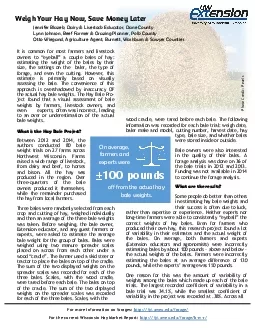

produced their own hay this research project found a lot of variability in their estimaWeigh Your Hay Now Save Money Later Jennifer Blazek Dairy Livestock Educator Dane County Lynn Johnson Beef Farme ID: 875974
Download Pdf The PPT/PDF document "wood cradle were tared before each bale ..." is the property of its rightful owner. Permission is granted to download and print the materials on this web site for personal, non-commercial use only, and to display it on your personal computer provided you do not modify the materials and that you retain all copyright notices contained in the materials. By downloading content from our website, you accept the terms of this agreement.
1 wood cradle, were tared before each bale
wood cradle, were tared before each bale. The following information was recorded for each bale trial: weigh date, baler make and model, cutting number, harvest date, hay type, bale size, and whether bales were stored inside or outside. Bale owners were also interested in the quality of their bales. A forage analysis was done on 36 of the bale trials in 2012 and 2013. produced their own hay, this research project found a lot of variability in their estima Weigh Your Hay Now, Save Money Later Jennifer Blazek, Dairy & Livestock Educator, Dane County Lynn Johnson, Beef Farmer & Grazing Planner, Polk County Otto Wiegand, Agriculture Agent, Burnett, Washburn & Sawyer Counties For more information on forages: http://fyi.uwex.edu/forage/ For the current Wisconsin Hay Market Report: http://fyi.uwex.ed off from the actual hay Photo Credit: Pexels the hay. Legume-only bales had a crude protein (CP) content of 17.1% of dry matter (DM). Grass-legume mix and grass only bales had CP levels of 15% and 11.1%, respectively. On the other hand, the legume bales had the lowest total digestible nutrients content of all three hay type categories, with just 57.3% of DM. The grass-legume mix bales had the highest levels at 60.2% and the grass-only bales had 59.6%.Getting accurate hay bale weights is a way to take the gamble out of managing hay. A 100 pound error adds up in extra cost or lost feeding potential. As an example, con-sider Grade 1 hay (125 to 150 RFV/RFQ) at $100 per ton for large round bales. An overestimation of 100 pounds per bale is a loss of $10 per bale for the buyer. Weighing individual bales in a load can be impractical for most farms. Often farmers haul loads of hay to local semi-truck scales to determine the average per bale weight. This process provides you with more accurate numbers than eyeballing. Accurate weights ensure that both buyers and sellers get a fair deal. Typically, buyers underestimate bale weights, while sellers overestimate. Before buying, selling, or feeding bales, it is important determining an accurate weight will help you to be better Proper planning for your livestocks forage needs is essential to keeping c
2 osts low and reducing waste. Even a slig
osts low and reducing waste. Even a slight under or over estimation of bale weights can hurt your bottom line, costing you time and money. the bale trials, the average coefficient of variability was 7.04%. The largest sample of bale trials was within the 4x5 round bale size. Both large round and large square bales were weighed. Bale trials were grouped into six categories of bale sizes: 4x4 (n=4), 4x5 (n=45), 4x6 (n=6), 5x5 (n=9), 5x6 (n=14), and 3x3x6 square (n=2). Bale trials were also grouped by the hay type: grass (n=31), grass-legume mix (n=31), and legume (n=11). Three bale trials were cornstalk or oat baleage. The size of the bale as well as the forage species which make up the hay all contribute to the weight of the bale. The average bale weights by size and by hay type Data was collected on bale storage for each of the bale trials. 80% of the bales were stored outside. Research has shown a reduction in nutritional quality as well as feed value over time for bales stored outside. The data collected in this research project strengthens that conclusion. For both grass and grass-legume mix hay, forage tests results on rela-tive feed quality (RFQ) were higher for bales stored under cover. Grass-legume mix bales stored outside had a RFQ of 111 (n=7) whereas bales stored under cover had a RFQ of 125 (n=6). Grass-only bales had a RFQ of 117 (n=3) for bales under cover compared to bales stored outside with a RFQ of 105 (n=17). There were not enough bale trials in the legume cat-egory to be able to make a correlation be-The nutritional content of the bales was as expected based on the manner in which the bales were stored and the forage species in Copyright © 2017 Board of Regents of the University of Wisconsin System doing business of the University of Wisconsin-Extension. All Rights Reserved. The University of Wisconsin-Extension provides Title action and equal opportunity in education, programming, and employment for all qualified persons regardless of race, color, gender, creed, disability, religion, national origin, ancestry, age, sexual orientation, pregnancy, marital or parental strecord or veteran status. Photo Credit: Otto Wiegand